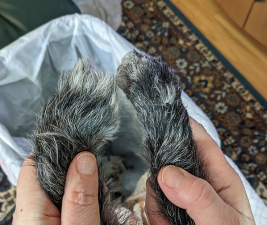Is your dog wearing fuzzy slippers? That’s what we call it when the fur on the bottom of Tango’s feet gets long and starts to cover his toe pads. You can see “before” and “after” in the picture. At (almost) 15 years old, Fran’s Brussels Griffon boy has enough trouble with mobility. He doesn’t need the added obstacle of fuzzy dog feet.
Even if your long-coated dog goes to the groomer on a regular schedule, it may help your dog get around more easily if you trim the fur on their feet between visits. For older dogs, who may not see too well and may have some issues with their joints, it’s a way to make sure they have better traction on hard floors.
Floor covering matters
What to use as floor covering is a balancing act when you have dogs. Hard floors like wood, laminate, tile or vinyl are easier to keep clean and fur-free. On the other hand, they’re not great for traction for the dog. We always cringe a bit when we see videos of people playing fetch with their dogs on hard floors. We don’t think it’s the least bit funny when the dog goes slip-sliding after the ball.
Unlike people who walk on the soles of their feet, dogs walk on their toes. The pads provide shock absorption and traction and their weight is supported only by the center two toes. The outer toes are non-weight bearing. It’s important to keep your dog’s nails short so their gait doesn’t suffer. If the nails grow past the pads, it has a negative impact on the dog’s ability to walk and run. Their nails shouldn’t hit the floor first. If you always hear the tip-tapping of paws, it’s time to trim their nails.
Check their toes
If the dog’s fur starts curling around their toe pads, it’s much more slippery for the dog to walk. The coarse skin dogs develop on their pads helps with traction, but the fur can interfere. Even some dogs with short coats, like our own Boston Terriers and French Bulldog, can grow longer fur between their toes that can cause problems with fuzzy dog feet. It’s a quick and easy fix – just take a look and trim off any fur that’s longer than their pads.
If your dog isn’t great for nail trims, or doesn’t like you to touch their paws, you can train them to accept it. Just take it slow. Introduce the concept just by giving the dog a treat when you touch or hold their paws. Having another person holding the dog makes the process easier, but most dogs will accept toe-fur-trimming when they realize it doesn’t hurt.
Tango lies tummy-up on Fran’s lap and falls asleep during the process. If your dog isn’t able to relax for the process, limit how much you do at any one time. If all your dog will allow is one foot, there’s always next time.
Time for a good look-see
Toe-fur trimming is a good time to check your dog’s feet for any issues. Look for anything abnormal. Over the years we’ve discovered various and sundry little issues that never became big ones. We’ve found swelling and infection at the base of Tango’s nail, Simon skinned a pad, Torque had an ingrown hair between his toes, etc. Caught early, none of these turned into a problem with a vet bill attached.
The whole toe-fur trimming is all about using an ounce of prevention. Just a couple minutes every few weeks is just a little bit of time that can prevent large problems.
Enjoyed this post? Click here to sign up for the weekly newsletter and never miss another!















